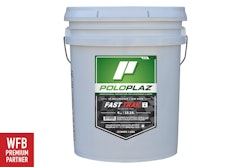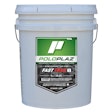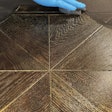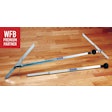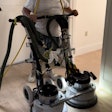The Problem
A contractor was attempting to recoat a gym floor at a college facility but could not get the finish to stick on a portion of the recoated floor.
The Procedure
The floor was at the basketball facility for a small Midwestern college. The entire facility had existing maple strip flooring that had been resanded and finished about five years ago and had been screened and recoated with oil-modified polyurethane about two years ago.
The contractor cleaned the entire floor with a water and vinegar mixture, then screened it with a 120-grit screen, cleaned it with vinegar and water again, and then, once the floor was dry, applied the polyurethane finish using an 18-inch T-bar.
He didn't run into any problems until he was almost done coating. The final part of the job to be coated was a long hallway that ran behind the bleachers between exterior doors and the concessions and restrooms. He first coated the side of the hallway next to the wall, then began coating the half of the hallway next to the bleachers. As he coated that second half, the finish started wicking away from the existing floor within about 30 seconds after application. It looked like water on a waxed car. The contractor then tried to use a brush to make the finish lay down, but the finish still wicked away.
The Cause
The problem the contractor described is "crawling." When the surface tension of the existing coating is too great, the next coat will crawl. The first thing to do is look for sources of contamination.
Each end of this hallway had doorways-one exterior door and one leading to another area of the building with a wax-coated linoleum floor. Neither doorway had a walkoff mat, so those areas were noted as possible sources of the problem. As I asked the contractor and the maintenance staff questions, we found a more likely suspect. The contractor mentioned that when he had originally walked by the bleachers, the floor had been so slick he'd almost fallen down. The maintenance staff showed us what they use to clean the wooden bleacher seats: a spray cleaning/polishing product. Two years of overspray of the bleacher cleaning product falling 15 feet from the last row of bleachers was enough to contaminate the floor finish on those first 2 feet of the floor adjacent to the bleachers.
How to Fix the Floor
First the new coat of finish must cure. Then the floor must be cleaned with a strong wood floor cleaner (not a daily maintenance cleaner) or a recommended solvent (for this finish, that would be mineral spirits) to chemically remove the contaminant before the floor is screened again. Remember this saying: cleaning before screening. Many people think if you screen a floor, you don't have to worry about cleaning, but just because you scratch the floor doesn't mean the finish sticks.
In the Future
When you're recoating any job, whether it's residential or commercial, you never know when and where you might run into a contamination problem. In this case, the contractor did many things right, including cleaning the floor before screening it (finish manufacturers no longer recommend using a water/vinegar combination as a cleaner, but this contamination wouldn't have been removed by a recommended daily maintenance cleaner, either). However, he should have figured out why the floor was so slippery before he started coating, and he should have done test areas throughout the floor, especially in the slippery areas. If he had, he might have spared himself the trouble of having to clean, screen and coat the floor again.














